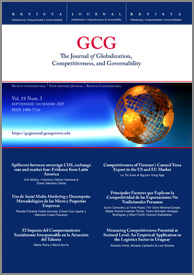Current Issue
We begin this issue by examining the contagion effects among sovereign Credit Default Swaps (CDS) markets, exchange rates, and market fear in Latin America. Erik Muñoz (University of Talca, Chile), Francisco Gálvez-Gamboa (Catholic University of Maule, Chile), and Elmer Sánchez Dávila (University of Lima, Peru) apply a time-varying parameter vector autoregressive model (TVP-VAR), identifying significant contagion effects across these markets. The sovereign CDS spreads of Colombia, Mexico, and Peru emerge as the main transmitters of risk, while the U.S. dollar and the euro act as dominant sources of volatility in foreign exchange markets. The authors reveal a bidirectional relationship between market fear, measured by the VIX and OVX indices, and CDS and exchange rates. These interactions increase vulnerability during periods of global uncertainty, underscoring the need for more prudent policies to manage financial risk in emerging economies.
To better understand the impact of Social Media Marketing on market business performance, Renata Edvania Costa Gouveia, Edvan Cruz Aguiar (Federal University of Campina Grande, Brazil), and Manoela Costa Policarpo (University of the Basque Country, Spain) analyze the relationship between entrepreneurs' attitudes and market performance using a serial mediation model involving technical knowledge and level of use. The authors’ analysis shows that level of use mediates the relationship between attitude and market performance, with both technical knowledge and level of use acting as key mediators.
In the next article, Marta Riera and María Iborra (University of Valencia, Spain) propose a model examining the consequences of corporate irresponsible behavior on a company’s ability to attract talent. They analyze how the relevance of the damage caused and the company’s intentionality affect talent attraction. The authors argue that the negative impact of irresponsible behavior on perceptions of employer attractiveness is particularly pronounced among Generation Z job seekers. However, the authors argue that the impact of CSI (Corporate Social Irresponsibility) incidents on talent attraction can be mitigated by the passage of time, geographical distance from the damage, and a company’s previously established reputation.
Xoan Le and Nga Nguyen (University of Economics and Law, Vietnam National University) analyze the competitiveness and key drivers of Vietnam’s canned tuna exports to the U.S. and European Union markets. The authors conclude that Vietnam has strong and growing competitiveness, driven by factors such as improvements in product quality, abundant domestic tuna resources, a highly open economy, favorable inflation conditions in both exporting and importing countries, and strategic export market selection. While recent adjustments in fisheries legislation have had a positive, though still uncertain, impact, competitiveness continues to face challenges from import tariffs, product quality restrictions, and the EU’s yellow card system.
To study the factors affecting Peru’s non-traditional exports, Joyce Consuelo La-Torre-Rojas, Flor Doris Medina-Quispe, Mayle Grecia Huaman-Torres, Pedro Bernabe Venegas-Rodriguez, and Albert Farith Chavarri-Balladares (Continental University, Peru) use an error correction vector to estimate the elasticities of China’s GDP growth (1.71%), the Eurozone’s GDP (0.11%), export prices (0.23%), the Baltic Dry Index (-0.06%), and agricultural wages (-1.06%) and their impact on export volumes. According to the authors, the greatest influence comes from the export index, followed by China’s GDP, prices, and wages. This underscores China’s central role as Peru’s primary trading partner and a key driver of Peruvian export trends.
Focusing on logistics activity in Uruguay, Roberto Horta, Micaela Camacho, and Luis Silveira (Catholic University of Uruguay) develop an innovative approach to measuring sectoral competitiveness. They propose the creation of a composite index to assess competitive potential (CPI). The CPI is built using a systematic methodology, rooted in a clear definition of competitive potential and structured around a theoretical model encompassing six dimensions. The authors draw on both primary and secondary data sources and apply multivariate analyses to validate the model’s analytical rigor and relevance. They conclude that this study represents a significant step toward improving the competitiveness of Uruguay’s logistics sector.
We would like to express our deepest appreciation to everyone who makes the success of this journal possible: members of the Advisory Board, Editorial Board, Editors and Associate Editors, reviewers, authors, and above all, our readers.
Editor in Chief
